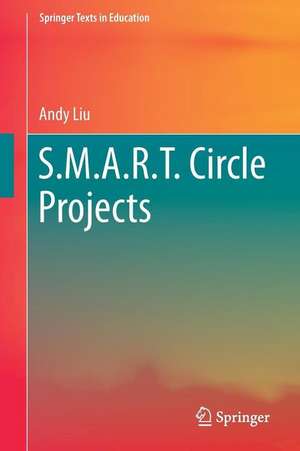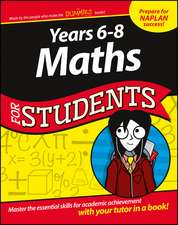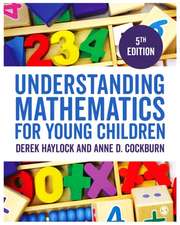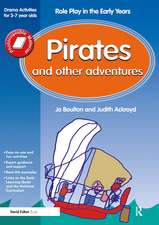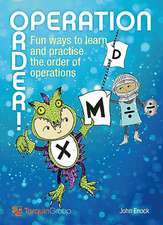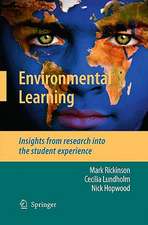S.M.A.R.T. Circle Projects: Springer Texts in Education
Autor Andy Liuen Limba Engleză Paperback – 18 sep 2017
This book describes projects in a Mathematical “Circle,” i.e., an organization that discovers and nurtures young mathematical talents through meaningful extra-curricular activities. This is the second volume in a trilogy describing in particular the S.M.A.R.T. Circle project, which was founded in Edmonton, Canada in 1981. The acronym S.M.A.R.T. stands for Saturday Mathematical Activities, Recreations & Tutorials.
This book, Volume II, is based on the papers published in scientific and education journals by the Circle members while they were still in junior high school (some still in elementary school). In essence, it explains the purpose of the Circle. Volume I describes how to run a Circle, and Volume III explains what actually takes place in the Circle. All three volumes provide a wealth of resources (mathematical problems, quizzes and games, together with their solutions). The books will be of interest to self-motivated students who want
Din seria Springer Texts in Education
- 17%
 Preț: 361.52 lei
Preț: 361.52 lei -
 Preț: 362.31 lei
Preț: 362.31 lei - 17%
 Preț: 360.93 lei
Preț: 360.93 lei - 17%
 Preț: 465.82 lei
Preț: 465.82 lei -
 Preț: 223.99 lei
Preț: 223.99 lei - 17%
 Preț: 458.71 lei
Preț: 458.71 lei - 17%
 Preț: 524.90 lei
Preț: 524.90 lei - 13%
 Preț: 353.19 lei
Preț: 353.19 lei - 17%
 Preț: 426.76 lei
Preț: 426.76 lei - 15%
 Preț: 581.01 lei
Preț: 581.01 lei -
 Preț: 397.27 lei
Preț: 397.27 lei - 15%
 Preț: 461.73 lei
Preț: 461.73 lei - 17%
 Preț: 426.16 lei
Preț: 426.16 lei - 17%
 Preț: 394.34 lei
Preț: 394.34 lei - 17%
 Preț: 362.70 lei
Preț: 362.70 lei - 13%
 Preț: 448.22 lei
Preț: 448.22 lei - 17%
 Preț: 457.35 lei
Preț: 457.35 lei - 17%
 Preț: 526.00 lei
Preț: 526.00 lei -
 Preț: 444.94 lei
Preț: 444.94 lei - 15%
 Preț: 579.34 lei
Preț: 579.34 lei - 15%
 Preț: 467.79 lei
Preț: 467.79 lei - 15%
 Preț: 582.80 lei
Preț: 582.80 lei - 15%
 Preț: 493.37 lei
Preț: 493.37 lei - 15%
 Preț: 578.37 lei
Preț: 578.37 lei -
 Preț: 449.15 lei
Preț: 449.15 lei - 15%
 Preț: 500.26 lei
Preț: 500.26 lei - 15%
 Preț: 587.02 lei
Preț: 587.02 lei - 15%
 Preț: 537.65 lei
Preț: 537.65 lei - 15%
 Preț: 694.37 lei
Preț: 694.37 lei -
 Preț: 392.97 lei
Preț: 392.97 lei -
 Preț: 487.57 lei
Preț: 487.57 lei -
 Preț: 500.46 lei
Preț: 500.46 lei - 15%
 Preț: 538.93 lei
Preț: 538.93 lei - 15%
 Preț: 592.77 lei
Preț: 592.77 lei - 15%
 Preț: 464.18 lei
Preț: 464.18 lei - 15%
 Preț: 499.26 lei
Preț: 499.26 lei - 15%
 Preț: 587.72 lei
Preț: 587.72 lei -
 Preț: 414.42 lei
Preț: 414.42 lei -
 Preț: 383.71 lei
Preț: 383.71 lei - 15%
 Preț: 698.80 lei
Preț: 698.80 lei - 15%
 Preț: 578.24 lei
Preț: 578.24 lei - 15%
 Preț: 707.78 lei
Preț: 707.78 lei - 15%
 Preț: 591.79 lei
Preț: 591.79 lei -
 Preț: 382.57 lei
Preț: 382.57 lei - 15%
 Preț: 648.24 lei
Preț: 648.24 lei - 18%
 Preț: 738.52 lei
Preț: 738.52 lei -
 Preț: 386.00 lei
Preț: 386.00 lei - 19%
 Preț: 501.95 lei
Preț: 501.95 lei
Preț: 384.70 lei
Nou
Puncte Express: 577
Preț estimativ în valută:
73.63€ • 76.58$ • 61.70£
73.63€ • 76.58$ • 61.70£
Carte tipărită la comandă
Livrare economică 13-27 martie
Preluare comenzi: 021 569.72.76
Specificații
ISBN-13: 9783319568102
ISBN-10: 3319568108
Pagini: 218
Ilustrații: XIV, 220 p. 158 illus.
Dimensiuni: 155 x 235 mm
Greutate: 0.34 kg
Ediția:1st ed. 2018
Editura: Springer International Publishing
Colecția Springer
Seria Springer Texts in Education
Locul publicării:Cham, Switzerland
ISBN-10: 3319568108
Pagini: 218
Ilustrații: XIV, 220 p. 158 illus.
Dimensiuni: 155 x 235 mm
Greutate: 0.34 kg
Ediția:1st ed. 2018
Editura: Springer International Publishing
Colecția Springer
Seria Springer Texts in Education
Locul publicării:Cham, Switzerland
Cuprins
Preface.- Table of Contents.- Chapter 1. Error-Correcting Codes.- Section 1. From the Alt Code to the Hamming Code.- Section 2. Two Applications of the Hamming Code.- Section 3. Reed-Muller Code.- Chapter 2. Regular and Semi-regular Polyhedra.- Section 1. Regular Polyhedra.- Section 2. A Polyhedral Metamorphosis.- Section 3. Semi-Regular Polyhedra.- Chapter 3. Polyform Compatibility.- Section 1. Tetris Number Theory.- Section 2. Tetris Algebra.- Section 3. Other Compatibility Problems.- Chapter 4. Mathematical Chess Problems.- Section 1. Adventures of an Apprentice Rook.- Section 2. Martin Gardner’s Royal Problem.- Section 3. Knight Tours.- Chapter 5. Mathematical Induction.- Section 1. The Towers of Hanoi.- Section 2. A Problem on Greatest Common Divisors.- Section 3. Congo Bongo.- Chapter 6. Number Triangles.- Section 1. Pascal’s Triangle.- Section 2. Rascal’s Triangle.- Section 3. Triangles of Asbolute Difference.- Chapter 7. Summation Formulae.- Section 1. Sums of Powers of Integers.- Section 2. Zig-Zag.- Section 3. Two Great Escapes.- Chapter 8. Finite Projective Geometries.- Section 1. Lions and Ponies.- Section 2. Star Wars.- Section 3. Convenient Buildings.- Chapter 9. Sharing Loots.- Section 1. Sharing Jewels.- Section 2. Sharing Gold and Silver.- Section 3. Sharing Rum.- Chapter 10. Puzzling Adventures.- Section 1. Circuits Checking Circuits.- Section 2. The Coach’s Dilemma.- Section 3. The Campers’ Problem.- Appendix Additional Problems.
Notă biografică
Andy Liu is an established author with eleven books to his credit. He is Professor Emeritus of the Department of Mathematical and Statistical Sciences at the University of Alberta, Canada. He has won numerous international awards in mathematics teaching and outreach, as have several of his former students. He was the leader of the Canadian team to the International Mathematical Olympiad in 2000 (South Korea) and in 2003 (Japan), acts as Vice President of the Tournament of Towns and ran the S.M.A.R.T. Circle for over 30 years.
Textul de pe ultima copertă
This book describes projects in a Mathematical “Circle,” i.e., an organization that discovers and nurtures young mathematical talents through meaningful extra-curricular activities. This is the second volume in a trilogy describing in particular the S.M.A.R.T. Circle project, which was founded in Edmonton, Canada in 1981. The acronym S.M.A.R.T. stands for Saturday Mathematical Activities, Recreations & Tutorials.
This book, Volume II, is based on the papers published in scientific and education journals by the Circle members while they were still in junior high school (some still in elementary school). In essence, it explains the purpose of the Circle. Volume I describes how to run a Circle, and Volume III explains what actually takes place in the Circle. All three volumes provide a wealth of resources (mathematical problems, quizzes and games, together with their solutions). The books will be of interest to self-motivated students who want to co
nduct independent research, teachers who work with these students, and teachers who are currently running or planning to run Mathematical Circles of their own.Caracteristici
Provides first-hand information on the history of the first Mathematical “Circles-Project” in North America Contains many mathematical problems, puzzles and games as well as their solutions Includes material based on junior high school student work, which was originally published in scientific and education journals The author has received numerous teaching awards Includes supplementary material: sn.pub/extras
